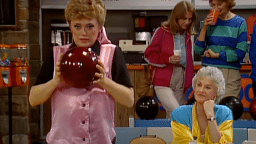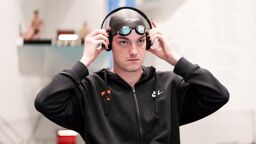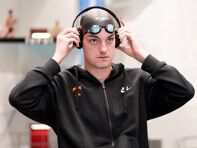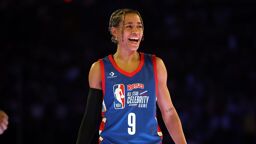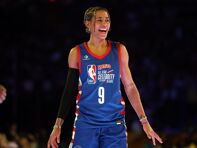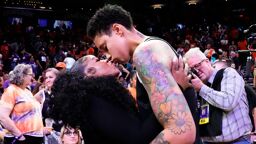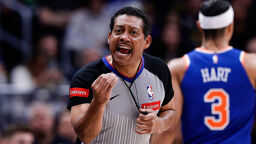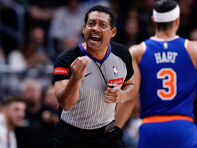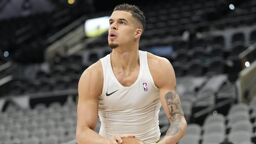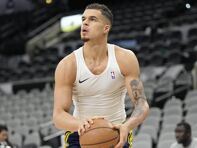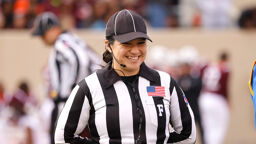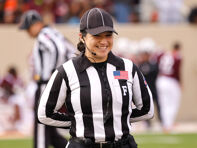(This story was published in 2003).
By: Douglas Robson
MELBOURNE, Australia — Crisp volleys, deft returns and well-placed serves once again pushed Martina a Grand Slam title. But it’s not Martina Hingis. It’s Martina #1, Grande Dame Navratilova.
At 46 and nearing AARP eligibility, Navratilova still has enough game to compete with players almost 30 years her junior. That point was illustrated at the Australian Open, where she and partner Leander Paes teamed up to win the mixed doubles finals.
“This goes beyond any wildest dream,” Navratilova said after her win. She became the oldest person to ever win a Grand Slam title.
Earlier in the tournament, the 57-time Slam titlist teamed with Russian teenager Svetlana Kuznetsova and advanced to the third round of women’s doubles before bowing out to No.1 seeds and eventual champions Venus and Serena Williams. Not bad for someone who not only played on the recently dedicated Margaret Court Arena, but actually played the famed Aussie legend back in the 1970s.
“I do remember playing Margaret,” said Navratilova after her first round doubles win, recalling their 1975 quarterfinal clash. “Looking back, I cannot believe they put her on an outside court while there was some insignificant men’s match going on the center court,” she said.
Though she has been featured in mainstream advertising campaigns aimed at gays and lesbians and has been involved in a number of other LGBT activities, lately Navratilova has kept her observations between the lines. She declined to talk about her personal life outside of tennis.
But in interviews over the course of the last week, she was her usual forthright self, expounding upon the state of the women’s game, her comeback, a possible leadership role with the Women’s Tennis Association (WTA) and whatever else was flung her way.
Since retiring from singles in 1994, Navratilova has continued to participate in Grand Slam doubles competitions and in some smaller events. Last year, she was granted a singles wild card in the Wimbledon tune-up at Eastbourne and
advanced to the second round.
In 2000, however, she decided to play a fuller, though limited, schedule, and has racked up two doubles crowns, including an event on the Gold Coast of Australia with 17-year-old Kuznetsova earlier this month. At 46 years, 2 months, 17 days, Navratilova is the oldest player in history to win a WTA Tour event, a record she set at 45 with a victory in Madrid last year.
The Gold Coast win gives her a career mark of 168 titles in both singles and doubles — more than any man or woman. On court, Navratilova still looks stylish and fit. In her sleeveless top, orange sneakers and backwards-turned cap–a statement perhaps that she can still hang with the youngsters–she both looks and plays like she belongs.
What keeps her going–she says she’ll play “as long as the body’s willing and as long as I want to”–is a love for the game and a hunger to improve.
Asked if she was surprised to be winning against players young enough to be her children, Navratilova quipped: “The ball doesn’t know I’m 46.”
The Quest for Excellence
So what provides motivation?”The quest for excellence–and trying to do everything I can to be the best player at this time.”
She sympathizes with veteran players who are bombarded about their age, such as Andre Agassi and Pete Sampras, both over 30, and 29-year-old Monica Seles. While all are still capable of challenging and winning majors, the barrage of questioning can start to undermine confidence, Navratilova said.
“The last 10 years of my career whenever I lost a match it was because I was too old,” she explained. “It wasn’t because the other guy or girl played better. When you’re 22, they say, ‘Oh, she had a bad day, or somebody played better.’ But when you’re 32, you shouldn’t be playing any more, even when the other person played a good match. That starts getting into your psyche and it’s hard to keep fending off those questions.”
Despite her experience, the 18-time Grand Slam singles champion still gets butterflies before matches and continues to tinker with her strokes. Though she has played a staggering 1,663 professional singles and doubles matches, she said her “knees knock” before play begins. And she has moved her forehand grip to a more Western position to generate more topspin, she said.
While she jokes that she’s “more trying to remember how I used to play” than make wholesale changes to her game, “Technically, I think I’m better than I’ve ever been.”
Where she’s been is a tennis odyssey in itself. Navratilova showed up on the scene in the early 1970s as a chunky, shy Czechoslovakian teenager. Over the next 25 years, she defected from her homeland, struggled to learn English, and came out — all under intense public scrutiny. That didn’t stop the net-hugging lefty from becoming the all-time leader with 167 singles and 165 doubles titles–until her comeback in 2000 added a couple more.
Her outspokenness and intelligence in a sport of over-managed teenage prodigies allowed her to transcend the game. She brought a new athleticism and power to the sport. And as her personal life, more than most players, became entangled with her professional life, she became a lesbian icon around the world. To be sure, she paid the price for her frankness, earning far less in commercial endorsements than her peers (few that there were) and certainly less than her story of immigrant-turned-champion merits.
“Blow Up” the WTA
But she has had few regrets. A big topic of discussion on the grounds of Melbourne Park last week was the leadership exodus once again decimating the WTA. Both CEO Kevin Wulff, who came over from Nike Inc. little more than a year ago, and president and COO Josh Ripple, announced they were leaving organization within the next few months.
“Something needs to be done now,” Navratilova said of the floundering WTA. “I said 15 years ago they should blow it up and start over. I still feel that way.”
She would even consider taking on the role herself, perhaps in a joint-position with someone possessing a business background.
“I can certainly provide the visibility,” she said. “I wouldn’t say no if that’s the only way to get somewhere because I would hate to see the game suffer if I can make a difference. It’s like being the lesbian icon. I didn’t ask to be a spokesperson for the gay movement but I just got thrown into it by who I was. Sometimes you get thrown into leadership roles because there’s nobody else there to pick up the slack.
The bottom line: “If it was thrust to me, I couldn’t walk away because I love the game too much.”
Even if the WTA is in disarray, the game is not, Navratilova argued. “The product is the best it’s ever been,” she said. “We have Everything–the personalities, the different backgrounds, different countries, different languages, different sizes and different colors.” It’s the structure of the sport–a messy entanglement of agents, tournament directors and players all grabbing for power–that inhibits its growth.
On the political front, Navratilova was highly critical of the pending review of Title IX by the U.S. Department of Education. The federal mandate bars sex-based discrimination in government-funded education programs and has been a major boost for female athletics.
Said Navratilova: “All the stuff that’s going on in our country right now, we worry about Title IX. But then, you know, Roe v. Wade is under review as well. It’s like going back in time. You know, it’s sort of like taking back Affirmative Action. If it ain’t broke, don’t fix it.”
“Players Burn Themselves Out”
Still able to win titles in her mid-40s, the Prague-born player, who became a U.S. citizen in 1981 and now resides in Aspen, Colo., says the physical demands of the tour means few players will be able to compete as long as she has. The reason? Joint-buffeting surfaces and the grueling 10-month season.
“It’s possible, but the players burn themselves out because they play too much on hard courts at a young age,” she said. If she were running a tennis academy, players would practice on clay and grass and only play on hard courts once a week. “The joints can’t do it,” she said.
As for her namesake, Martina Hingis, Navratilova said she’s concerned the former No. 1 won’t return to the tour. It was reported last week that foot injuries could sideline the Swiss Miss for good. Hingis is already taking an extended break from the tour, which began last October.
“That’s obviously really bad for tennis,” she said. “I hope she comes back and plays because she’s a lot of fun to watch, adds a different dimension to the game.”
With such a storied career, Navratilova doesn’t rue many of her 213 losses as a player. But isn’t there just one she’d like to have back? “I need two. I couldn’t pick,” she said. “The Conchita Martinez final (at Wimbledon in 1994), and the semifinal with Helena Sukova here in Melbourne in 1984. I lost 7-5 in the third (to Sukova). It would have been the seventh Grand Slam (in a row).”
While there isn’t a lot she hasn’t seen in tennis, Navratilova says she still picks up a few things from today’s great ball strikers.
“I learn more from watching good hitters, good players, like (France’s) Fabrice Santoro, and (Switzerland’s) Roger Federer, the artists out there.”
Takes an artist to know an artist.
Douglas Robson is a tennis writer based in San Francisco.





